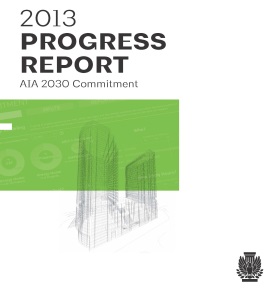
by Brianna Crandall — November 10, 2014—The AIA 2030 Commitment Program, a voluntary initiative introduced in 2009 for architecture firms and other entities in the built environment to commit their practice to advancing the American Institute of Architects’ goal of carbon-neutral buildings by the year 2030, has produced a report assessing the program’s progress.
There is some very encouraging data in this report that shows how architects are making measurable progress towards reducing the carbon emissions in their design projects, said AIA Chief Executive Officer, Robert Ivy, FAIA. But one of the major findings from our research is that in order to maximize the energy efficiency of buildings and to realize our ultimate goal of carbon-neutral buildings, energy modeling must become a standard part of the design practice.
The key findings from the new report, AIA 2030 Commitment 2013 Progress Report, include:
- 401 design projects meeting the 60% carbon reduction target a 200% increase from 2012
- 2,464 projects accounted for in this report a 150% increase form 2012
- 1.6 billion gross square feet (GSF) represented in this data a 9% increase from 2012
- 66% of total GSF using energy modeling to predict operational energy consumption a 14% increase form 2012
- 19% average firm reduction in Lighting Power Density for interior projects a increase of 2% from 2012
- 34% average Predicted Energy Use Intensity reduction reported by firms a decrease of 3% from 2012
- 7% of total GSF meeting the current 60% carbon reduction target a decrease of 7% from 2012
- 99 firms submitted reports a 10% decrease from 2012
The decrease in the number of firms reporting data is mainly attributed to the time and effort involved in tracking and entering project data, explains the AIA. To address that situation, the AIA has partnered with the Department of Energy (DOE) to create the 2030 Design Data Exchange to provide a more user-friendly interface and allow firms to anonymously research how their projects are predicted to perform compared to similar projects in the AIA 2030 Commitment portfolio. This new reporting tool will be made available in late December 2014 or early January 2015.
Visit YouTube for a video preview of the functionality of the 2030 Design Data Exchange.





